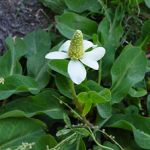| Common Name: |
Yerba del manso |
| Other Names: |
Yerba mansa, swamp root |
| Botanical Name: |
Anemopsis californica |
| Genus: |
Anemopsis |
| Family: |
Saururaceae |
| Cultivation: |
Constantly moist to wet soil, including heavy clay, in full sun. |
| Propagation: |
By separation of rooted plantlets that form along the stolons, or by seed sown when ripe in pots of soil mix that should be stood in water. |
| Harvest: |
Roots are dug at any time (though most potent when dormant), wilted, then sliced into small sections and dried for tinctures and powder. Leaves are picked at any time for infusions. |
| Native Location: |
SW United States and Mexico |
| Height: |
15cm (6in) |
| Width: |
Indefinite |
| Hardiness: |
Z8-10 |
| Parts Used: |
Roots, leaves |
| Properties: |
A healing, diuretic, anti-inflammatory herb with antibacterial and antifungal effects. |
| Medicinal Uses: |
Internally for peptic and duodenal ulcers, cystitis, urethritis, arthritis, amebic dysentery. Externally for slow-healing wounds, boils, anal fissure, diaper rash, and muscular or joint aches and pains. Leaves are much weaker than roots but work well for healing baths and washes. |
| Bibliography: |
Encyclopedia of Herbs by Deni Brown. Copyright © 1995, 2001 Dorling Kindersley Limited. pg 121
|

